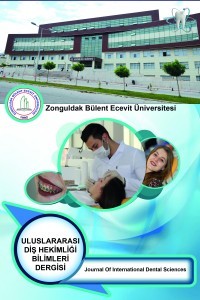REÇİNE DİŞLERDE KURVATÜRLÜ KANALLARIN İKİ FARKLI EĞE SİSTEMİ İLE TRANSPORTASYON MİKTARININ KARŞILAŞTIRILMASI
Amaç: Bu çalıĢma amacı, iki farklı eğe sistemi ile Ģekillendirilen kurvatürlü palatinal kanala sahip reçine diĢlerdeki apikal transportasyon miktarını karĢılaĢtırmaktır.
Gereç ve Yöntemler: ÇalıĢmamızda 3D printer ile basılmıĢ reçine diĢlerin (n=24) 135 derecelik kurvatüre sahip palatinal kanalları kullanıldı. ġekillendirme öncesi kanal içine kırmızı boya enjekte edildi. Her diĢ Ģekillendirme sonrasında çakıĢtırma sağlamak için hazırlanmıĢ sabit bir düzeneğe yerleĢtirildi ve palatinal kanal lateralden fotoğraflandı. DiĢler 15 nolu K tipi eğe Ģekillendirildikten sonra her grupta 12 diĢ olacak Ģekilde TwistedFile Adaptive (Axis/SybronEndo Orange, CA, ABD), ve Scope W Gold (GTech Dizayn, Yozgat, Türkiye) eğeler ile hareketine uygun olacak Ģekilde Ģekillendirildi. ġekillendirmesi biten diĢler tekrar boyanıp fotoğraflandı. ġekillendirme öncesi ve sonrası görüntüler bilgisayar programı ile çakıĢtırıldı. Apeksten 5 mm uzaklıkta olacak Ģekilde kanalın en kurvatürlü yerinden transportasyon miktarı değerlendirildi.
Bulgular: Her iki eğe sistemi arasında istatistiksel olarak anlamlı bir fark bulunmamıĢtır (p>0,05).
Sonuç: TwistedFile Adaptive ve Scope W Gold eğesinin apikal transportasyon miktarları arasında istatistiksel olarak anlamlı bir fark bulunamadı. Her iki eğe sistemi farklı özelliklere sahip olmasına rağmen kanalın kurvatürünün eĢit Ģekilde korumuĢtur.
Anahtar Kelimeler:
Nikel Titanyum, Transportasyon, Reçine DiĢ., Nickel Titanium, Transportation, Resin Teeth.
COMPARISON OF TRANSPORTATION AMOUNT OF CURVATURE ROOT CANALS ON RESIN TEETH WITH DIFFERENT FILE SYSTEM
Objective: The aim of this study is to compare the amount of transport of resin teeth in the curvature of the palatal canal with two different file systems.
Materials and Method: In our study, palatal canals of 3D-printed resin teeth (n=24) with a curvature of 135 degrees were used. Red dye was injected into the canal space before preparation. Each canal was photographed from the lateral side from the same angle by creating a mechanism. After the teeth were shaped 15# K file (n=12) and shaped to suit its movement with TwistedFile Adaptive (Axis/SybronEndo Orange, CA, ABD) and Scope W Gold (GTech Dizayn, Yozgat, Türkiye) files. The teeth, whose shaping was completed, were painted and photographed again. The pre- and post-operative images obtained were superimposed on the computer. The amount of transport of the canal was evaluated at a distance of 5 mm from the apex.
Results: There was no statistically significant difference between the two file systems (p.>0.05).
Conclusion: No statistically significant difference was found between the apical transport of TwistedFile Adaptive and Scope W Gold files. Although both file systems had different properties, the curvature of the canal was equally preserved.
Keywords:
Nickel Titanium, Transportation, Resin Teeth.,
- ISSN: 2149-8628
- Yayın Aralığı: Yılda 3 Sayı
- Yayıncı: Zonguldak Bülent Ecevit Üniversitesi
Sayıdaki Diğer Makaleler
TRAVMA SONUCU KOMPLİKE KRON KIRIĞI OLUŞMUŞ DĠİŞİN GECİKMİŞ REATAÇMAN VE TOTAL AMPUTASYON TEDAVİSİ
FLUORİD JEL UYGULAMA SÜRESİNİN FİSSÜR ÖRTÜCÜLERİN YÜZEY PÜRÜZLÜLÜĞÜNE ETKİSİ
Melek BELEVCİKLİ, Gamze KILIÇ, Edanur ÇAKIR
ANTERİOR TEK DİŞ EKSİKLİĞİNDE Tİ-BASE ABUTMENT İLE ZİRKONYUM KRON RESTORASYONU: OLGU SUNUMU
Duygu Ece KESKİN, Feyza AKSU OLCAY, Ayşegül KÖROĞLU, Seda CENGİZ
BİYOSERAMİK ESASLI KÖK KANAL PATLARI
TÜRK ÇOCUK DİŞ HEKİMLERİNİN KANITA DAYALI DİŞ HEKİMLİĞİ UYGULAMALARINA DAİR BİLGİ VE TUTUMLARI
DİŞ HEKİMLERİNİN STRESLE MÜCADELESİNDE EVCİL HAYVANLARIN ROLÜ
Orhan ÇİÇEK, Büşra KUMRULAR, Büşra DEMİR ÇİÇEK
